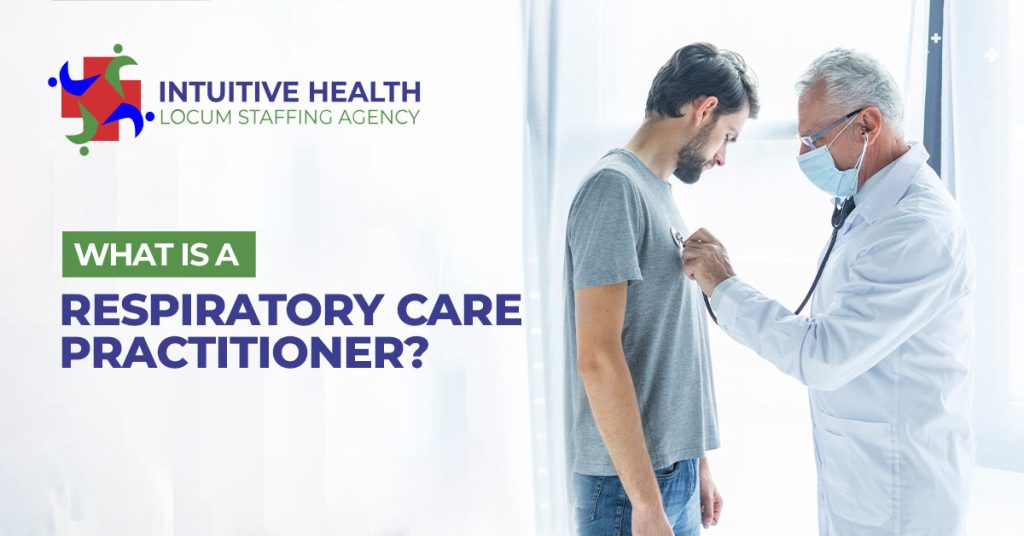Every breath is life. Yet for many, breathing is not simple. Air pollution, asthma, COPD, and long COVID affect millions worldwide. These conditions make breathing a daily struggle.
Respiratory care has never been more important. In hospitals, clinics, and homes, skilled professionals step in when patients cannot breathe well. They bring comfort, relief, and life-saving support.

One of the most vital roles is the respiratory care practitioner (RCP). These professionals test, treat, and guide patients with breathing disorders. Their work blends science, skill, and compassion.
This blog will explain who RCPs are, what they do, where they work, and why they matter. By the end, you will see how they make a difference in patient lives and the healthcare system.
What Is a Respiratory Care Practitioner?
A respiratory care practitioner (RCP) also known as pulmonologist is a licensed healthcare worker. They help patients who have trouble breathing. They test, treat, and support people with lung conditions. Common conditions include asthma, COPD, pneumonia, and sleep apnea.
The title “Respiratory Care Practitioner” may sound confusing. In the U.S., it is often used instead of “Respiratory Therapist.” Both roles mean the same in most states. However, some hospitals and state boards prefer “RCP” as the legal title.
An RCP’s scope of practice is broad. They check oxygen levels, run lung tests, and set up breathing devices. They manage ventilators, provide oxygen therapy, and guide patients in care. In clinics, hospitals, and even at home, they help people breathe better.
The key goal of an RCP is simple. They make sure every patient gets the right breathing support at the right time.
RCP vs Respiratory Therapist: What’s the Difference?
The terms used in respiratory care can cause confusion. Many people hear “Respiratory Care Practitioner” and “Respiratory Therapist” as different jobs. In reality, the two titles often mean the same role. Some states or hospitals use “RCP” as the legal name. Others prefer “Respiratory Therapist.”
A Registered Respiratory Therapist (RRT) is an advanced credential. This title comes after passing the NBRC’s higher-level exam. An RRT has more training than a new graduate. They often handle complex cases, ICU patients, or teaching roles.
A Certified Respiratory Therapist (CRT) is an entry-level credential. This shows the professional passed the basic NBRC exam. Some states allow CRTs to practice, while others require RRT.
The Advanced Practice Respiratory Therapist (APRT) is a newer role. This expands practice with more decision-making, much like nurse practitioners.
In short, RCP is the broad title. CRT and RRT show the level of credential. APRT shows advanced clinical training. Knowing these differences helps patients and students avoid confusion.
Suggested Reads: What is the role of an occupational therapist assistant?
Core Duties & Responsibilities of a Respiratory Care Practitioner or Pulmonologist
A pulmonologist carries many duties each day. Their work blends science, skill, and patient care. They move between tests, treatments, and support based on patient needs.
Diagnostics
RCPs test how well a patient’s lungs work. They run pulmonary function tests (PFTs) to measure breathing strength. They check blood gases (ABGs) to see oxygen and carbon dioxide levels. They also use oximeters to monitor oxygen saturation. These tests guide doctors in making care plans.
Treatment
Respiratory Care Practitioner give treatments to help patients breathe better. They set up and manage ventilators in ICUs and deliver oxygen therapy for patients with COPD or pneumonia. They even provide aerosol therapy and inhalers for asthma care. They also use CPAP or BiPAP for sleep apnea.
Patient Support
RCPs teach patients how to use inhalers correctly. They show breathing exercises for people with chronic lung issues. They guide families on handling oxygen tanks or machines at home. This support helps patients stay safe after leaving the hospital.
Critical Care
In emergencies, RCPs play a fundamental role when in ERs, they respond to breathing distress. In ICUs, they adjust ventilators and support critical patients. They act fast when seconds matter most.
Daily Life Example
A patient with COPD may arrive struggling to breathe. The RCP checks oxygen levels, gives an inhaler treatment, and reassures the patient. Later, they teach the patient simple breathing exercises before discharge. This shows how RCPs impact both hospital care and daily life.
Moreover, RCPs test, treat, teach, and support. Their mix of duties helps patients breathe easier every day.
Education, Credentials & Licensure
Apart from education and certifications, you can become a respiratory care practitioner (RCP) or pulmonologist with proper training. The minimum education is an associate’s degree in respiratory therapy. Some students choose a bachelor’s degree for broader options. Programs must be accredited by the Commission on Accreditation for Respiratory Care (CoARC). Accreditation ensures the program meets national standards.
After graduation, candidates take exams from the National Board for Respiratory Care (NBRC). The first exam leads to the Certified Respiratory Therapist (CRT) credential. A higher-level exam gives the Registered Respiratory Therapist (RRT) credential. Many states require the RRT for full practice.
Every state has its own licensing rules. Most require proof of NBRC certification, a license application, and fees. Renewal is needed every few years with continuing education.
Pulmonologist may also pursue specialty certifications. These include neonatal or pediatric care, sleep medicine, and pulmonary rehabilitation. Specialty training helps RCPs work with specific patient groups.
Education and credentials shape the quality of respiratory care. With proper training, RCPs gain the skills to support patients safely and effectively.
Read More: What Does a Clinical Psychologist Do?
Where Do Pulmonologists of Respiratory Care Practitioner Work?
Pulmonologist or (RCPs) work in different settings because each workplace brings unique duties and patient needs.
In hospitals, pulmonologists serve in ICUs, ERs, and neonatal units. They manage ventilators, monitor critical patients, and respond to emergencies. In neonatal intensive care, they support newborns with underdeveloped lungs.
In outpatient clinics, RCPs focus on long-term care. They help patients with asthma or COPD through pulmonary rehab. They also guide patients with sleep apnea in sleep disorder clinics.
In home health, RCPs visit patients who need daily support. They manage oxygen therapy, set up ventilators, and teach families safe equipment use.
Pulmonologist may also take on specialty roles. Some work in neonatal or pediatric care. Others join transport teams to assist patients during transfers. Telehealth is another growing area, where RCPs monitor breathing remotely.
These diverse settings show the flexibility of the RCP role. Wherever patients struggle to breathe, RCPs bring vital care.
Technology & Tools Used by Pulmonologists
Respiratory care practitioners (RCPs) rely on many tools every day. These devices help them test, treat, and monitor patients safely.
Equipment includes ventilators, CPAP, BiPAP, and oxygen concentrators. Ventilators support critical patients in ICUs. CPAP and BiPAP help those with sleep apnea. Oxygen concentrators deliver steady oxygen to patients at home.
Diagnostic tools guide care decisions. Spirometers measure lung strength and breathing patterns. Pulse oximeters check oxygen saturation quickly. ABG analyzers test blood gases to track oxygen and carbon dioxide levels.
Digital innovations are reshaping respiratory care. Telehealth allows RCPs to guide patients remotely. Remote monitoring devices track oxygen levels from home. AI is starting to support diagnostics and predict breathing risks.
These tools expand how RCPs deliver care. From hospital wards to home visits, technology makes breathing support safer and smarter.
Also Read: What Can a Certified Nursing Assistant Do?
Skills & Personal Qualities Needed
Respiratory care practitioners (RCPs) need strong skills and personal qualities. Their role mixes technical ability with compassion and teamwork.
Technical expertise is vital. RCPs must handle machines safely and interpret results quickly. Small mistakes can affect patient safety.
Communication skills help patients and families understand care. Clear teaching builds trust and improves home care success.
Compassion and empathy ease patient fears during treatment. A calm, kind approach makes difficult moments less stressful.
Problem-solving is key in emergencies. RCPs must think fast when patients cannot breathe.
Stamina and teamwork are needed in busy hospitals. Long shifts and high-pressure units require both strength and support.
These qualities define the best RCPs. They blend skill with heart to help patients breathe easier.
Patient & Healthcare System Impact
Respiratory care practitioners (RCPs) make a clear difference in care. They improve outcomes by restoring steady breathing and preventing complications.
According to scientific research, differences exist in end-of-life discussions between patients with cancer and those with chronic obstructive pulmonary disease (COPD). The study identified key themes, including timing, recognizing cues, communication boundaries, and managing emotions, suggesting that the emotional dimension plays a critical role in care planning.
RCPs help reduce hospital stays and avoid readmissions. With timely treatment and patient education, they keep patients healthier at home.
They also improve cost efficiency for healthcare systems. Preventing emergencies lowers costs for both patients and hospitals.
From the patient’s view, RCPs bring comfort and guidance. Patients can expect breathing tests, therapy support, and clear instructions. They explain devices and exercises in simple steps.
This mix of clinical care and personal support shows why RCPs matter. They save time, reduce costs, and give patients confidence in their care.
Common Myths & Misconceptions About Pulmonologists/Respiratory Care Practitioners
Many people have the wrong idea about respiratory care practitioners (RCPs). Clearing up myths helps patients understand their true role.
Myth 1: RCP is the same everywhere.
In truth, the title and duties can vary. Some states call them “Respiratory Therapists.” Others use “Respiratory Care Practitioner.” The scope depends on state laws and licensing.
Myth 2: They only work in hospitals.
RCPs are active in many places. They work in clinics, sleep labs, and even home care. They also support telehealth and transport medicine.
Myth 3: RCPs only handle machines, not patients.
While they manage ventilators and oxygen devices, they also teach and guide patients. They explain treatments, reduce stress, and give long-term support.
These myths limit how people see the profession. RCPs are not just machine operators. They are skilled caregivers who combine science and compassion to help patients breathe easier.
Conclusion: Why Pulmonologist/RCPs Matter Today?
Respiratory care practitioners (RCPs) are vital in modern healthcare. They test, treat, and support patients who struggle to breathe. They manage emergencies, guide long-term care, and teach patients daily skills.
Their impact reaches far beyond the hospital walls. For patients, RCPs bring relief, comfort, and confidence. For providers, they add support, accuracy, and teamwork. For the healthcare system, they reduce costs, shorten stays, and prevent readmissions.
Every breath matters, and RCPs protect that breath. Their blend of skill, empathy, and quick action saves lives every day.
If you are a patient, knowing the RCP role helps you feel prepared. If you are exploring a healthcare career, it shows a path full of purpose and growth.
At Intuitive Health Services, we connect skilled RCPs or Pulmonologists with trusted facilities across the U.S. As a leading healthcare staffing agency, we help professionals find the right match to grow and thrive.

